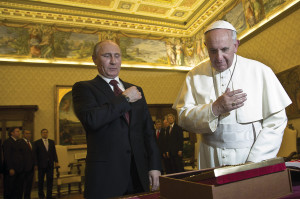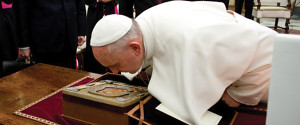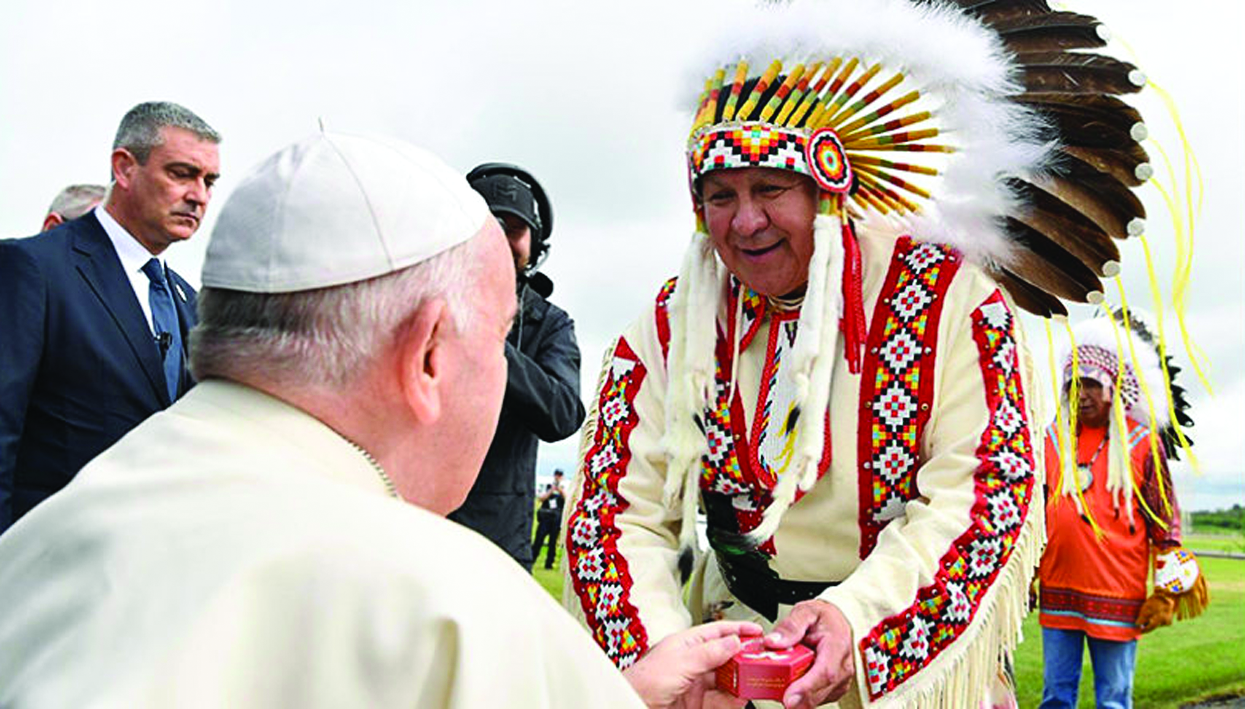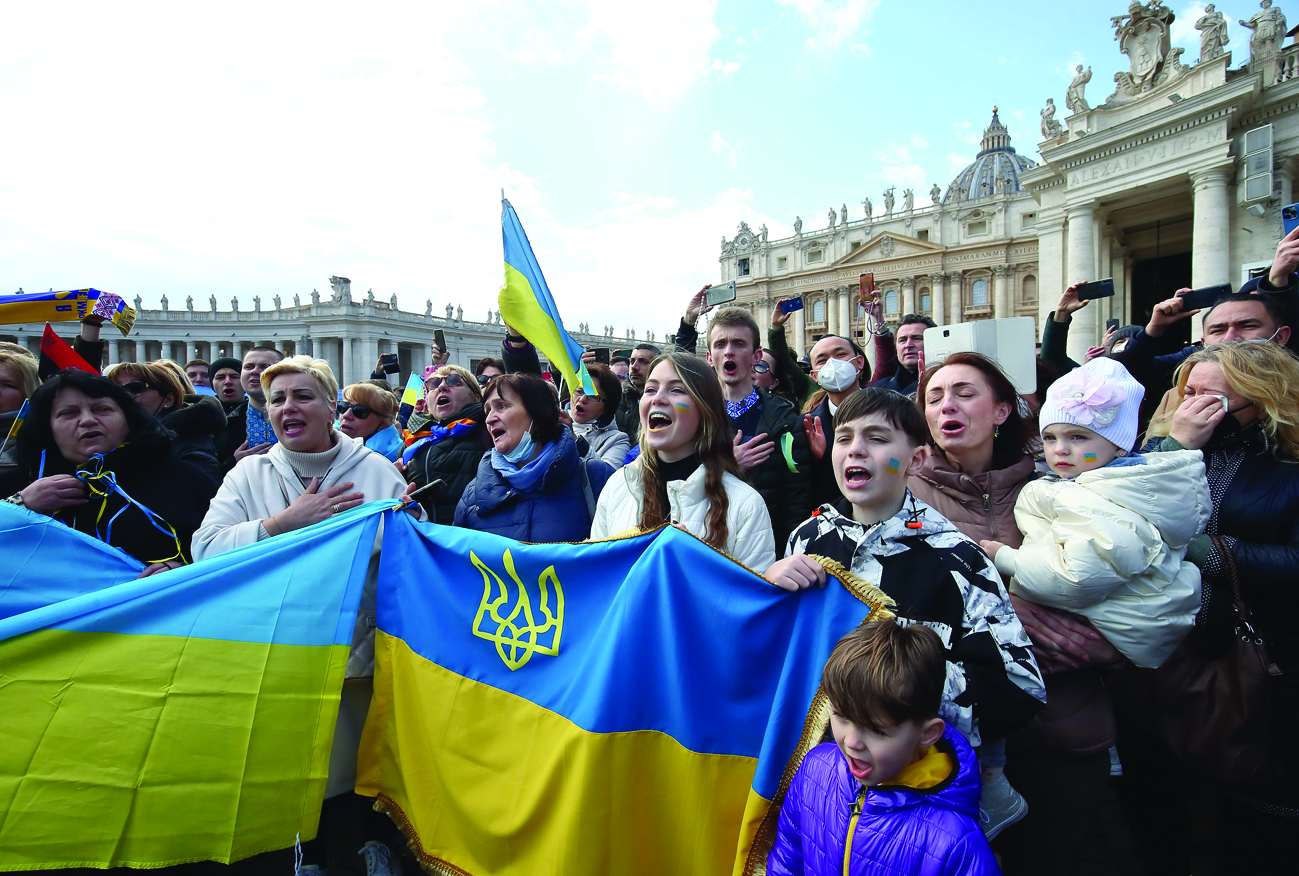Monday, November 25, 2013: Moscow visits Rome. Pope Francis and Putin have an historic and private meeting at the Vatican for the first time.

Pope Francis and Vladimir VladimirovičPutin during an audience in the Pope’s private library in the Apostolic Palace on November 25 (Galazka photo).
On Monday afternoon, November 25, in Rome, Pope Francis received Russian President Vladimir Putin, who is increasingly positioning himself as a defender of the embattled Christians of the Middle East, for about 35 minutes of private talks in the Apostolic Palace. (Putin was about 50 minutes late for the meeting.)
Two main points were at the center of the talks, according to a Vatican press communiqué released after the meeting: the situation of the Catholic Church in Russia and the grave situation of civil war in Syria. (In the box on this page is the official Vatican communiqué on the meeting.)
From the communiqué, we know that the two men gave “special attention” to the “grave situation in Syria.” Pope Francis on September 7 called for a day of prayer and fasting for peace to avoid the possible outbreak of a wider war in Syria, and a wider war has not broken out, though the situation remains violent and unsettled. Therefore, the two men placed “emphasis” on “the urgency of the need to bring an end to the violence” and “to ensure necessary humanitarian assistance for the population.”
The preferred means to bring about the end to violence: “negotiation,” which involves “the various ethnic and religious groups” now pitted against one another in civil strife.
But this is not all that happened at the meeting.The two men also exchanged gifts. And that exchange of gifts placed an icon of the Virgin Mary at the center of their historic meeting (see paragraph at the end of this article).
The Issue of Ukraine
The deeper background for this meeting involves a number of evolving “policy positions” where cultural, religious, political and economic interests intersect.
“Putin does not quite style himself as a Christian emperor, but in at least two ways he has been seeking recently to present himself as a sort of moral guardian and policeman with international standing: as an upholder of socially conservative values, especially over homosexuality, and as an advocate of peace, and in particular the welfare of vulnerable Christian minorities, in the Middle East,” the Economist of London wrote in its coverage of the historic meeting. “Russia’s claim to be using its influence constructively in the Middle East was enhanced, in many people’s eyes, by the deal it brokered to dismantle Syria’s chemical weapons arsenal and hence avert American air-strikes on that country. Whatever the consequences for the region as a whole, Russia’s intervention certainly boosted its claim to be protecting the region’s ancient Christian minorities.”
So, in this sense, Rome may be seeing in Putin a possible interlocutor, if not a full-fledged ally, in the current “culture war” over gender and family issues, and in the effort to defend the ever-diminishing presence of Christians in the Middle East.
A key “flashpoint” in this delicate diplomatic rapprochement is Ukraine.
Pope Francis has a great appreciation for Ukraine’s “Uniate” or “Greek-Catholic” Church. These Catholics use eastern liturgical rites, similar to those used by the Orthodox, but they accept the authority of the papacy.
A relatively little-known fact: the current head of the Ukrainian Greek-Catholics, Sviatoslav Shevchuk, 43, served in the pontiff’s native Argentina, in Buenos Aires. (On January 14, 2009, he was appointed auxiliary bishop of the Eparchy of Santa María del Patrocinio en Buenos Aires and consecrated bishop on April 7, 2009, by Archbishop Ihor Vozniak. On April 10, 2010, he was appointed apostolic administrator of the same diocese. By chance, Shevchuk was also in Rome in mid-November, and met with Pope Francis on the morning that Francis met with Putin…)
Meanwhile, the Russian Orthodox Church sees Ukraine as part of its “canonical territory” and brands the “Uniates” as “defectors” from Orthodoxy.
So when might Pope Francis visit Russia, to return the visit of President Putin to Rome? Only when ecclesiastical peace comes to Ukraine…
Just a few days ago, prior to Putin’s visit, Russian Orthodox Church head Patriarch Kirill hosted an influential Catholic archbishop in Moscow: Cardinal Angelo Scola of Milan.
“We live in an epoch when many of our historic differences should stop playing the critical role they have played in relations between our Churches,” Kirill said during their meeting, RIA Novosti reported.
Putin regularly makes public appearances at Russian Orthodox services on major holidays, and he has said he has read the Bible and even keeps a copy on his plane.
Putin formed a friendship with late Patriarch Alexy II and is close to the current head of the Russian Orthodox Church, Patriarch Kirill, who is a strong political ally.
Last week, at Christ the Savior Cathedral, Putin paid a visit to Kirill on his 67th birthday, presenting him with a lacquered box adorned with a picture of the Assumption Cathedral of the Trinity Lavra of St. Sergius, along with a bouquet of white roses.
There are only about 700,000 Catholics in Russia, accounting for about 0.5 percent of the population. In the 1940s, Soviet leader Joseph Stalin ordered the seizure of Eastern Catholic churches, mostly in the Ukraine, and granted the property to the Russian Orthodox Church. After the collapse of the Soviet Union in the early 1990s, Catholics took back more than 500 churches, mostly in Western Ukraine.
The Patriarch and the Pope have never met because of the dispute over these properties, which still simmers today.
On November 12, Pope Francis received at the Vatican the “foreign minister” of the Patriarchate of Moscow, Metropolitan Hilarion Alfeyev.
After the meeting, Hilarion spoke of the possibility of a meeting between Pope and Patriarch. “We are not yet ready to say when and where such a meeting may occur, but we are ready to prepare and work for such a meeting,” he said.
The Vatican and Russia established full diplomatic relations in 2009. (It has just been announced that the US intends to slightly downgrade its own embassy to the Vatican, closing its separate embassy to the Holy See on the Aventine Hill and moving that embassy into an annex of the American embassy to Italy on Via Veneto. In this perspective, as Russia moves closer to Rome, the United States seems to be moving ever so slightly away.)
EXCHANGE OF GIFTS:
AN ICON OF MARY AT THE CENTER OF THE MEETING
What else happened at this meeting, the first between Francis and the Russian leader?
The two men exchanged gifts, as is customary. And that exchange placed an icon of the Virgin Mary at the center of this first meeting between the Russian president and the Pope of Rome.
During the exchange of gifts, Putin showed off his religious side, blessing himself and reverently kissing an icon of the Virgin Mary that he gave to Pope Francis.
Francis gave Putin a ceramic mosaic of the Vatican gardens.
Putin presented Francis with an image of the icon of the Madonna of Vladimir, one of the most venerated of all religious icons for the Russian Orthodox faithful.
After they exchanged the gifts, Putin asked Francis if he liked the gift he had received, and Francis said he did.
Putin then crossed himself and kissed the image. Francis followed suit.
The Argentinian Pope has a profound devotion to the Virgin Mary. He visited the Basilica of St. Mary Major on the morning after his election, and there he prayed before an icon of the Madonna and Child known as the Salus Populi Romani. So his devotion to Marian icons is well attested.
Does this mean that relations between Rome and Moscow — and between the Catholic and Orthodox Churches, divided since 1054 — are now on a new level of warmth?
It is too early to say. But certainly one more important step has been taken…







Facebook Comments